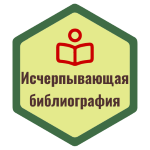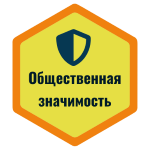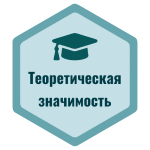Education is the stage in which a person forms his personality, acquires knowledge and skills for later life. Its importance has no boundaries as education provides a bright future for an individual. So, due to this every nation in the world tries to provide access to primary education for everyone. But, despite to this, today not everyone has equal opportunity in education. This is especially true for children with disabilities.
According to new data (UIS) for the school year 2023, approximately 250 million children and teenagers don't attend school (UNESCO, 2023.). Also, the report highlights if countries met their national SDG 4 targets, there would be important positive outcomes such as six million more children would be in preschool, 58 million more children and adolescents would be in school, and at least 1.7 million more primary school teachers would have been trained.
As Dahl and Lochner (2005) stated, socioeconomic support plays a critical role in children's education. They found that a $1,000 increase in income could lead to a 2.1 % improvement in math test scores and a 3.6 % improvement in reading test scores. This highlights the importance of providing socio-economic support to parents as it can have a positive impact on their children's academic performance. Regretfully, not every parent can afford this convenience. These differences make a gap in the digital world in which poorer children lose out. Lack of access to technology can limit their learning opportunities and make it difficult to develop vital skills.
According to UNESCO's 2022 MID-TERM PROGRESS REVIEW of SDG 4, the number of young women completing secondary school for every 100 young men globally increased from 102 to 105(UNESCO,2022). In sub-Saharan Africa, this number reached 84 to 88(UNESCO,2022). This shows that in these countries, women face significant inequalities in relation to education. For instance, most young women leave school due to marriage or childbirth. This indicates didn't change by 20 years.
The College of Health Studies Milutin Milankovic (2022) research states that in some countries children with disabilities still attend special schools and are excluded from mainstream education. This emphasizes the importance and relevance of the problem of inclusive education.
After reviewing the general data on inclusive equity in education, I focused specifically on its policies and measures for a child's equity. I heard from many people that children with special educational needs are often excluded from mainstream education and forced to go to special classes. This makes the child feel excluded from society. Often, due to this, most children with disabilities don't have communication skills. It, in his turn, can spoil the future of a child.
Investigating inclusive equity in primary education and marginalized communities in Kazakhstan is something that personally interests me. After learning more about the problem, I can say that having inclusive education is essential to ensuring that every child receives a high-quality education. Regardless of their status, gender and disability situation, all children should have equal access to the education they need to succeed. In conclusion, it is important to find solutions to reduce the exclusion of children with SEN from general education and to ensure them equal attitude toward education and social life
Literature review
Current day, despite the fact that Kazakhstan has made significant progress in the field of education, problems between different layers of society in our state continue to worsen, especially with regard to the issue of inclusive education. Unfortunately, many children with disabilities in Kazakhstan continue to be excluded from regular schools and do not have equal educational opportunities. This literature review examines existing research and studies to identify targeted policies and measures that can be implemented in Kazakhstan to improve inclusive equity in primary education for marginalized communities.
According to Mccarty (2006), through IDEA, which was passed in 1991, every student has the right to the best and least limitive environment (LRE). To integrate special education pupils in same age in mainstream schools, to emphasize a more inclusive society that does not exclude any person, the law which was accepted.
According to UNESCO (2009), inclusive education is adequate education for all students while respecting their diversity in terms of educational needs. Today, inclusive education poses a significant challenge to global education systems. In the upcoming sentences will be discussed teachers' concerns about inclusive education and how it specifically influences their attitudes. Teachers quite often and consistently point out the lack of resources to include students with SEN. They report increased workloads, increased classroom management demands and reduced quality of education when involving students in SEN programs. Also today, a serious problem among French teachers is the increased workload on students with special educational needs. Many teachers believe that allowing some students initially excluded from school to participate and offering them the same learning opportunities could jeopardize their school's reputation.
Although segregation of students with special needs can promote student confidence and make it easier on the teachers, it also promotes many drawbacks (Wang, 2009). For instance, today t there exist challenges, such as increased stress and workload for teachers facing different teaching needs, potential distractions arising from different teaching styles, and lack of adequate training for general education teachers further compounds the stress. Wang holds the view that a common issue in education is the question of where we should place students with disabilities and the effectiveness of those placements (2009, p. 154)
College of Health Studies Milutin Milankovic(2022) study faced a with variety challenges.One of them,that in some countries children with disabilities still attend special schools and are excluded from mainstream education. To increase inclusivity, it is crucial to develop clear local and national policies with specific goals and to ensure adequate support for children with disabilities in the school environment (Werner et al.)
This study is comprehensive. The collection included 64 primary school teachers who were selected through a simple survey in three primary schools in Belgrade, Serbia in 2021. The teacher test used as a research tool was based on the thesis of Professor Rijk Struden, which was part of the project. «Education for Knowledge Communities» at the Institute of Education in Belgrade. The dependent factors that were measured in the study were related to the «primary grade» demands for co-curricular activities. Classical metrics were presented as fractal metrics, and the distribution of observed fractal metrics was found to differ from the expected fractal metrics.
Investing in special education policies is one way to overcome inclusive education. Of course, we will not be able to immediately include disabled children in general education. But with the help of scientists in other fields, and the time we devote to it, we can achieve this.
Investing in special education policies, namely national inclusive education programs and strategies, is one way to overcome inclusive education. Of course, we will not be able to immediately include disabled children in general education. But with the help of scientists from other fields and the time we put into it, we can achieve this. If we succeed, we will not only be able to develop inclusive education, but also improve our country. This is why this project will not only benefit the local community but will also bring brilliant development to the huge population that will be involved in this approach.
Methods
In this research project, quantitative method was used to collect data from primary and secondary sources as it allows for the collection of large amounts of data from a wide range of participants, providing a broad perspective on the research topic. To achieve my goal of improving inclusivity and equity in primary education for marginalized groups in Kazakhstan, in study i used multiple methods that were justified by their suitability to provide a good understanding of the research topic.
Survey was one of the major quantitative data collection methods used in this research. In the survey participated people of different ages, such as teachers, students and parents. But the main focus was on a group of parents who have children with special educational needs. Because their opinion about inclusive education reveals the whole truth about people’s attitude towards to this type of education in Kazakhstan, the level of its development and what problems there exist.
The surveys included questions related to awareness and level of inclusive education in Kazakstan.Also during the survey, respondents answered the question whether effective measures have been taken and what measures can be implemented to improve inclusive equality in primary education. The received data were analyzed using Microsoft Excel to identify the relationships between these data.
Several issues arose when collecting the quantitative data from survey. For instance, the study was limited to self-reported survey data. Self-reported data may contain biases and inaccuracies due to subjective interpretations and perceptions of respondents. To overcome this issue, survey questions will be carefully designed and efforts will be made to provide clear instructions and minimize response bias. Additionally, steps could be taken to build trust and rapport with participants, which may have contributed to more accurate and honest responses.
Moreover, the study has a limited number of questions. It means that the questionnaire contains only 10 questions. This limits the depth of respondents' responses, as they do not reflect their views.
To avoid such difficulties, using a more comprehensive survey with considerable questions will be a wise choice. Because this will give us the opportunity to understand the participants views. Also, using other data collection methods, such as in-depth interviews or focus groups may become good decision, due to they are provide additional, detailed information and allow participants to share their thoughts about inclusive education more openly.
The second method I used was to analyze secondary sources, such as policy documents, education reports, and scientific literature, which are complement the survey results. For instance, in September 2017, according to Catalina Devandas, UN Special Rapporteur on the Rights of Persons with Disabilities, Kazakhstan pays attention to things like investments in the development of education as a main point for evolving strong manpower but forgets about children with s SEN. This study emphasizes the importance of including an inclusion system in Kazakhstan education due to children with disabilities are often excluded from mainstream education and forced to go to special classes.
There are some potential limitations. First of all, secondary sources can be low quality and unreliable. In this case, they influence the entire context of your research. Also, they can alter the result of your research and distort its meaning.
Additionally, secondary sources may not be available or accessible. Because of this, the researcher collides with many problems in accessing comprehensive and relevant information. So, this limits the depth and breadth of your study.
In conclusion, I can say that this study employed methods of survey analysis and second source investigating, which assist in completely opening my research question: «What targeted policies and measures can be implemented in Kazakhstan to improve inclusive equity in primary education for marginalized communities?»
Results
In the survey take part people of different ages, starting from 14 years, such as teachers, students and parents. But the main attention was on a group of parents who have children with sen. Respondents were asked 10 questions to determine awareness and level of inclusive education, effective measures that were included and can be implemented to develop inclusive equality in primary education in Kazakhstan. Overall, 103 respondents participated in the survey.
Firstly, participants assessed the level of inclusive education in Kazakhstan to assist in finding out its exact development level. As shown in Figure 1, respondents were presented with 5 choices: very high, high, average, low, and very low. Additional information about what inclusive education means was given to ensure convenience. The majority of participants (43.17 %) selected average level as the answer more than any option. Also, 23,3 % of participants appreciated the level of inclusion as a high level. Additionally, 14.6 % of participants selected high level, while 11,7 % of participants chose high level. Furthermore, a minority of respondents (6.8 %) chose low-level.

Fig. 1. Question #3
Secondly, correspondents were asked about their level of awareness of equality and inclusion in Kazakhstan. As shown in Figure 2, respondents were given the opportunity to rate their knowledge on this topic on a scale from 1 to 10. Main of the participants were parents (65 out of 103) and the majority of them (16 from 65) indicated 7 as the answer. 13 person of 65 chose 5, 7 individuals selected 4,7 individuals chose 4, 6 chose 8 and 9, 5 chose 3,6,10 and only 1 chose 1,2. Other parts of respondents were not parents. In this case, a large number of them (10 out of 38), the same as the group of parents, appreciated the level of awareness as 7. Also, 6 participants picked 4, 5 chose 6, 5 selected 6 and 8 and only 3 people chose 3,5,9,10. It is compulsory to notice that no one picked 1 and 2. These details gave an understanding of the correspondent's view.
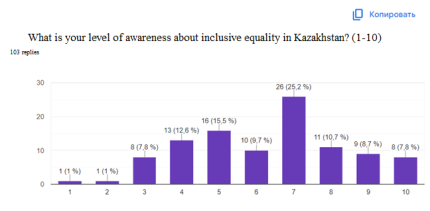
Fig. 2. Question #4

Figure 3. Question #5
Moreover, to find out the opinion of individuals on the possibility of involving students with special needs in the general school, the fifth question was queried. Based on survey results, people at the age of 14 -17 years think that it is impossible to include disabled children in mainstream school. In the same way think 9 individuals of 18–26 age,11 people between 27 and 37,10 respondents in the range of 38 and 50 age and 3 participants who are more than 50 years. On the other hand, 4 correspondents don't agree with the statement that claimed that children with SEN potentially can be implanted in the general education system. Also 9 persons in the range of 18 and 26, 23 participants between 27 and 37 age,19 individuals of 38 -50 and 2 people above 50 years too don't believe this idea. In general,43.7 % of respondents answered «Yes» and 56,3 % of participants answered «No» to question.
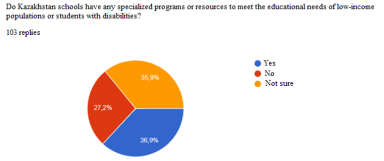
Fig. 4. Question #6
When students were asked existence of any specialized programs in Kazakhstan schools to ensure the educational needs of low-income families, it was clear that most of them were not confident themselves. Interestingly, in Figure 4 the amount of number of participants who answered to question «Yes» was more than 1 person than individuals who answered «Not confident». This completely shows that many Kazakh citizens have no idea if the government is taking any measures or actions regarding inclusive education. Overall, 36.9 %(38 out of 103) of correspondent know about authority inclusive programs,35.9 %(37 from 103) of participants are not sure if any inclusive program exists and 27.2 %(28 out of 103) of individuals are unaware about that.
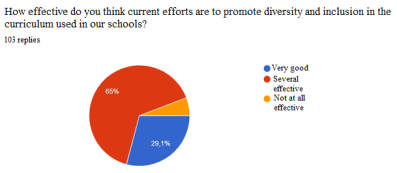
Figure 5. Question #7
To identify the effectiveness of modern action, of promoting diversity and inclusivity in school programs, the question «How effective do you think the current measures to promote diversity and inclusivity in the curricula used in our schools are?" was asked. As a result, 65 % of participants (67 out of 103) think that it was somewhat effective, while the other 29,1 % (30 out of 103) think that it was very effective. Also, a minority of respondents (5.8 %(6 people)) believe that it was non efficient.
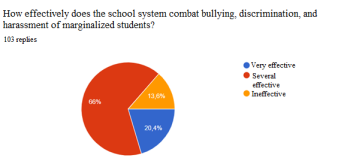
Fig. 6. Question #8
Moreover, question 8 asked to understand respondents' perspectives about whether effectively the school system combats bullying, discrimination, and harassment of marginalized students. The majority of participants (66 %) chose somewhat effective as the answer, while 23,3 % (21 from 103) of individuals appreciated the level of school system combat bullying as a very high level. Additionally, 13.6 % (14 from 103) of participants selected non-effective as the answer. The results indicate that schools ensure the safety of students and care for their school life by preventing bullying, discrimination, and harassment of pupils. But, due to their acceptance of not so very effective measures, bullying still proceeds. This almost shows that school programs against the abuse of disciples by each other must be improved.
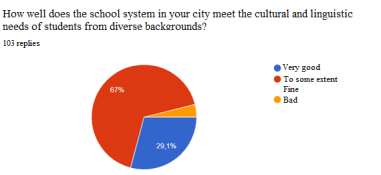
Fig. 7. Question 9
During the analysis of the question of whether the school system in your city meets the cultural and linguistic needs of students from diverse backgrounds, as shown in Figure 7, there were revealed that 67 %(69 out of 103) of correspondents answered «Somewhat good», while 29.1 %(30 out of 103) of participants answered «Very good» and the minority of respondents(3.9 %) answered «Bad».

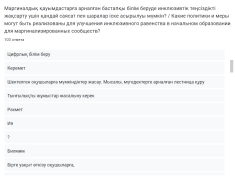
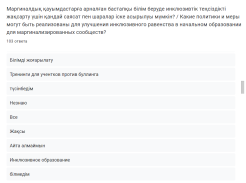
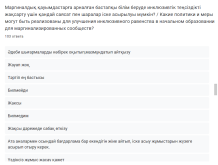
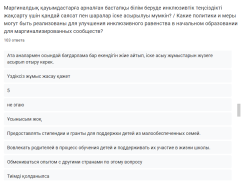
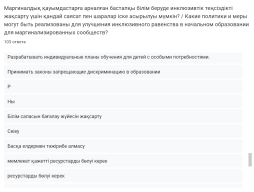

Fig. 8. Question #10
The next section of the survey focused on policies and measures that can be implemented to improve inclusive equity in primary education for marginalized communities. Continually mentioned answers included anti-bullying training for students, the necessity to tell parents about the existence of such a program and work on its implementation, promoting exchange experiences with other countries on this issue, providing more literary works and expressing them in content, studying disciples to discipline, creating “Learning Together” schools. To this last open question, many answered that they did not know or had no suggestions. Only about 10 people honestly answered the question. This demonstrates that many people do not know what policies and measures can be implemented to improve inclusive equality
In conclusion, all these results presenting to us with insights and views of all participants on the topic of inclusive education in Kazakhstan. Most of the correspondents understand the meaning of conclusive education and think that it is in our county at enough level. These findings help to reach the aim of the research, especially to find policies and measures to ensure equal access and quality education for children with special educational needs.
Conclusion
With regards to the challenges faced by marginalized communities in accessing inclusive primary education, statistics from the College of Health Studies Milutin Milankovic's (2022) study demonstrate that in some nations, children with SEN are excluded from general education and forced to go to special classes. It means that the problem of inclusive education nowadays is still meaningful and vital. This is not good for the local community because this can reduce the self-esteem and communication skills of disciples, which may make a child feel excluded from society and spoil their future. If this happens, Kazakhstan can lose potential workers or intelligent groups of people who can bring benefits to the community. So, it is extremely important to ensure that regardless of student status, gender, or disability, all children need to have equal access to the education they need to succeed.
Concerning how effective the current targeted policies and measures have been in improving inclusive equity in primary education for marginalized communities in Kazakhstan, according to the study «On the Margins: Education for Children with Disabilities in Kazakhstan» (2019,June 18), in August 2017, the Almaty City Department of Education created an inclusive education program in each of Almaty's eight school districts, where education specialists, resource rooms, and aides to assist children with disabilities were provided. However, the number of students with SEN in these inclusive schools remains significantly lower. Only 68 were classified as having «particular educational needs» when 7,000 disciples registered in five general inclusive schools in Almaty. It means that the effectiveness of inclusive education in Kazakhstan is not so excellent. This is not good for the whole of Kazakhstan because less effectiveness brings enormous problems, such as reducing social cohesion and understanding of different layers of society. Thus, prejudice and discrimination between various social structures will increase more than at any time. If efficiency is high and vice versa, interaction and collaboration among people will be at a high level, and social cohesion will be easily built.
Concerning what additional policies and measures can be implemented in Kazakhstan to further enhance inclusive equity in primary education for marginalized communities, according to the survey that was done, the government can provide anti-bullying training for students, promote exchange experiences with other countries on this issue, provide more literary works and express them in content, study disciples to discipline, and create “Learning Together” schools. Thus, in Kazakhstan, there will be various measures that will be efficient. This will be a good choice because these politics and gauges help to support inclusive equality between different social structures.
Further study is needed to exactly answer the research question, «What targeted policies and measures can be implemented in Kazakhstan to improve inclusive equity in primary education for marginalized communities?" due to their potential limitations.
References:
- Mccarty, K. (2006). Full Inclusion: the Benefits and Disadvantages of Inclusive Schooling an Overview.https://files.eric.ed.gov/fulltext/ED496074.pdf
- “On the Margins” | Education for Children with Disabilities in Kazakhstan. (2019, June 18). Human Rights
- Watch. https://www.hrw.org/report/2019/03/14/margins/education-children-disabilities-kazakhstan
- Wang, H. L. (2009). Should all students with special educational needs (SEN) be included in mainstream education provision? — A critical analysis. International Education Studies, 2(4). https://doi.org/10.5539/ies.v2n4p154
- United Nations. (2017). Report of the Special Rapporteur on the rights of persons with disabilities (A/HRC/37/56). Retrieved from https://digitallibrary.un.org/record/3843478?ln=en&v=pdf
- UNESCO (2009). Policy Guidelines on Inclusion in Education. Paris: UNESCO.
- Werner et all(2021). Can self-efficacy mediate between knowledge of policy, school support and teacher attitudes towards inclusive education? PLoS ONE 16, e0257657. doi: 10.1371/journal.pone.0257657







